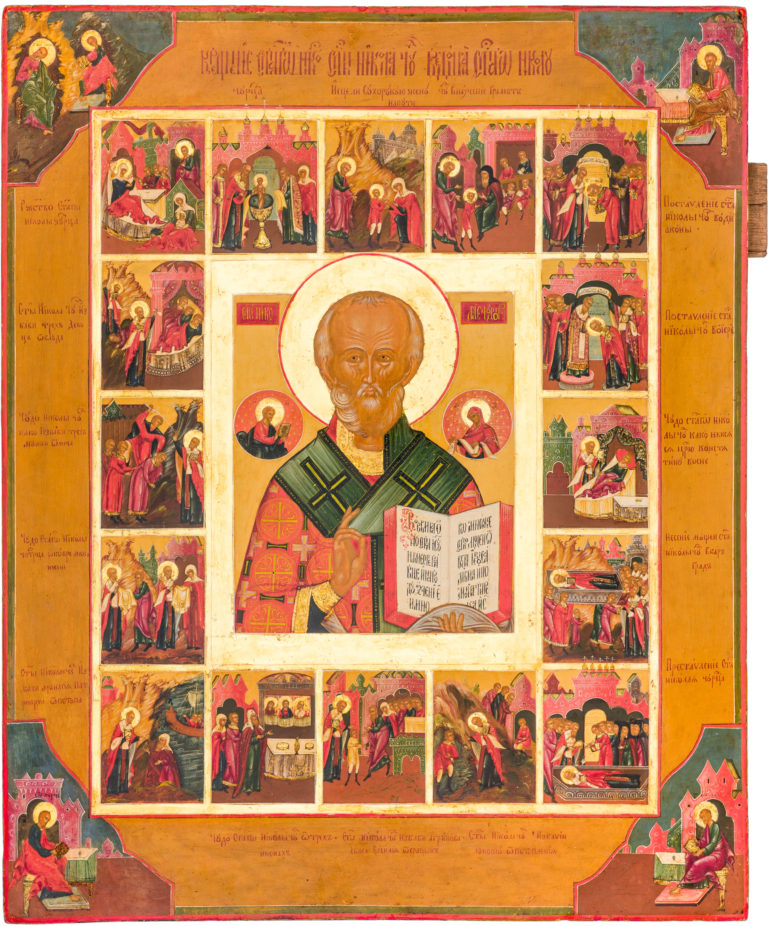Saint Nicholas—the Archbishop of Myra, with 16 Hagiographical Border Scenes
Antique Russian icon. Second half of the 19th century. Icon-painting centers of the Vladimir region (possibly Palekh).
Size: 53 х 43 х 3 cm
Wood (two panels), profiled incut support boards, a shallow incut centerpiece, underlying layer of canvas is not visible, gesso, tempera, gold.
The author’s paintwork is in very good condition with only slight chafing and fallouts of gesso on the borders of the religious icon.
Contact us

Saint Nicholas—the Archbishop of Myra, with 16 Hagiographical Border Scenes
Diagram of the border scenes:
- The Nativity of Saint Nicholas;
- The Baptism of Saint Nicholas. The Miracle in the Font;
- The Healing of the Withered Woman;
- The Education of Saint Nicholas;
- Saint Nicholas is ordained Deacon;
- The Miracle of the Three Maidens;
- Saint Nicholas is ordained bishop;
- The Delivery of Three Men from Execution;
- The Appearance of St. Nicholas to the Emperor Constantine in his sleep;
- The Miracle of the Carpet;
- The Delivery of the Patriarch Athanasius from Drowning;
- The Miracle of the Three Icons;
- The Liberation of Basil, the son of Agricus, from the Saracens;
- The Delivery of Demetrius from the Bottom of the Sea;
- The Dormition of Saint Nicholas;
- The Translation of the Relics of St. Nicholas to Bari.
Saint Nicholas of Myra is one of the most venerated saints of the Christian world. He was born in the second half of the 3rd century in Asia Minor to pious Christian parents who pledged that their son would serve the Lord. One of the first miracles of the saint happened at his baptism – when the baby stood for three hours in the baptismal font (border scene 2). From the youngest age, Nicholas strove to the ascetic life, spending time studying the New Testament. His uncle – the Bishop of Patar – seeing the young man’s zeal for God, ordained Nicholas a priest. The Vita of St. Nicholas tells us of his humility, mercy, and the fervent desire to come to the aid of those who suffered. He retained these qualities throughout his life, even after being elected and ordained the Archbishop of Myra in Lycia (present day town of Demre in Turkish Asia Minor). In 325, Nicholas took part in the First Ecumenical Council that condemned the Arian heresy. According to the Church tradition, Saint Nicholas hit the heretic Arius and for this offense was stripped of his episcopal authority and thrown into prison. Soon many of the Council Fathers experienced a vision in their sleep of Christ and the Mother of God personally giving Saint Nicholas the two most important symbols of the episcopacy – the Gospel and the omophorion. This vision, which served as the official reason for the reinstatement of Nicholas in the episcopacy, became known as “The Miracle of Nicaea” and is depicted in almost all religious icon paintings of the saint. In the given antique Russian icon, it is shown in the centerpiece, with Christ and the Mother of God depicted half-length in medallions.
In Russia, Saint Nicholas has been widely venerated since the pre-Mongolian era. The presented religious icon depiction of Saint Nicholas belongs to the oldest and best-known iconographic type: it is a half-figure portrait of the saint vested in a cross-ornamented phelonion, with his right hand in a blessing gesture and his left covered hand holding the Gospel. The selection of border scenes in this hand-painted icon is traditional, with the majority dedicated to various miracles of the saint. One of the usual St. Nicholas icon scenes is the “Healing of the withered woman” (border scene 4) – a miracle performed by Nicholas when he was just seven. The hagiographical border scenes of Eastern Orthodox icons depicting St. Nicholas often include the story of the three maidens (border scene 6) pushed by their broke and despaired father to prostitution in order to save the family from starvation. By hearing this, Saint Nicholas secretly came in the night to their house and threw three bags of gold to the Maidens, thus saving the family from the moral fall. The most popular miracle was the delivery of three men from execution (border scene 8) when Nicholas broke through to the executioner and stopped his sword from descending on the wrongly condemned. One of the more popular Imperial era St. Nicholas icon scenes is the “Miracle of Three Icons” (border scenes 11 and 12). According to this legend, Saint Nicholas appeared to the Elder Theophanes and asked him to commission three religious icons – of the Savior, of the Mother of God, and of himself. When the holy icons were finished, they were brought to the Ecumenical Patriarch Athanasius, who refused to bless the St. Nicholas icon, ordering it to be removed. After this, Patriarch Athanasius left by sea and was soon engulfed in a storm. He was saved only after praying and asking forgiveness of Saint Nicholas. The border scenes of this antique Russian icon actually break the chronology: the Salvation of the Patriarch Athanasius is shown before his refusal to bless the St. Nicholas icon. Imperial-era hagiographical hand-painted Orthodox icons of Saint Nicholas end with the scenes of the Dormition (the saint died at a great age around the year 345) and the Translation of His Relics to the Italian city of Bari in 1087, after Myra was taken by the Turks. The last scene also breaks the chronology and is depicted in this antique icon over the Dormition of Saint Nicholas.
The traditionalist execution of the religious icon paintings, the use of bright, resonating colors that stand out on the gold background, the flat and monochromatic approach to the faces – all attest to the fact that this St. Nicholas icon was painted in one of the centers of the Vladimir region, possibly Palekh. The given antique Russian icon clearly belongs to the second quarter of the 19th century.